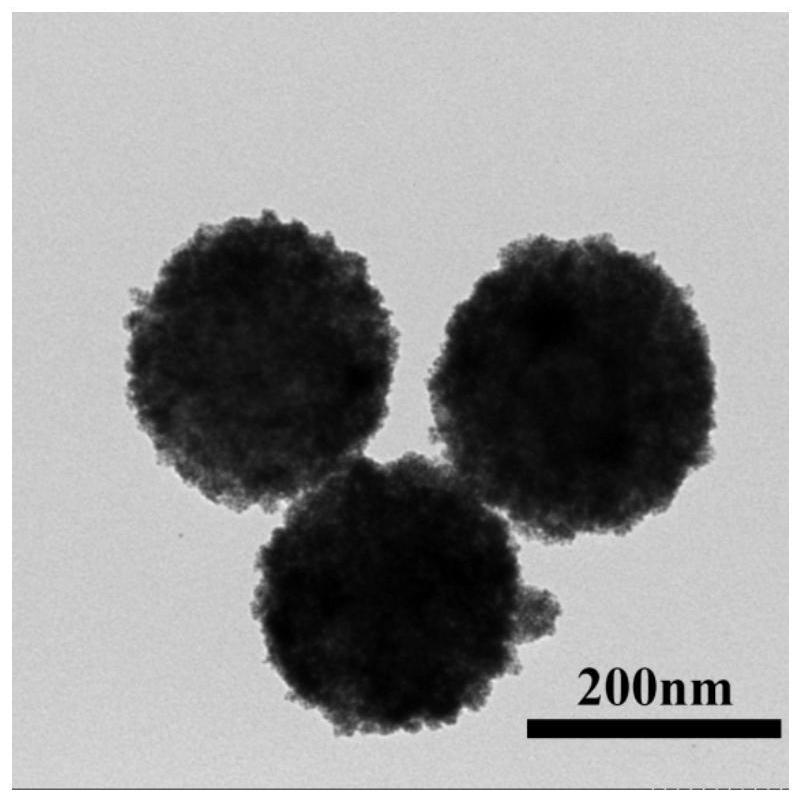A kind of polydopamine nanodiagnostic agent and preparation method thereof
A polydopamine nanometer and polydopamine technology, applied in the field of biomedical materials, can solve the problems of oxygen consumption, aggravate tumor tissue hypoxia, adverse photodynamic therapy, etc., and achieve the effects of improving hypoxia and improving catalytic activity.
- Summary
- Abstract
- Description
- Claims
- Application Information
AI Technical Summary
Problems solved by technology
Method used
Image
Examples
Embodiment 1
[0039] Embodiment 1: Preparation of Rh@MPDA nanoparticles
[0040] (1) Preparation of MPDA nanoparticles:
[0041] The carrier mesoporous polydopamine MPDA is prepared from the reference literature, and the particle size is about 200nm.
[0042] Weigh 0.15g of dopamine hydrochloride and 0.1g of F-127, dissolve them in 10mL of ethanol and ultrapure water 1:1 system, stir for 20min to fully dissolve and mix. In an ultrasonic water bath, slowly add 160 μL of TMB, ultrasonic for 3 minutes, the solution becomes milky white visible to the naked eye. Then add 375 μL of ammonia water, the solution turns dark brown, stir on a magnetic stirrer for 2 hours, and centrifuge for 10 minutes (13000 rpm / min, 4°C) to collect the precipitate. Wash once with ethanol, wash twice with ultrapure water, and finally resuspend with ultrapure water to obtain the mesoporous polydopamine solution.
[0043] (2) Preparation of Rh@MPDA nanoparticles:
[0044] Centrifuge 10 mL of 1 mg / mL mesoporous polydo...
Embodiment 2
[0047] Embodiment 2: Preparation of Rh@MPDA nanoparticles
[0048] (1) Same as Step 1 of Example 1;
[0049] (2) Same as Step 2 of Example 1, except that 1 mL of 10 mg / mL rhodium trichloride hydrate solution was added.
[0050] (3) Transmission electron microscope observation:
[0051] After fully ultrasonically dispersing the Rh@MPDA nanoparticles prepared above, they were added dropwise onto the copper grid, dried overnight in the air at room temperature to collect the copper grid, and observed with a transmission electron microscope. The transmission electron microscope picture is as follows: image 3 shown. As can be seen from the figure, the distribution of rhodium nanoparticles in the above-mentioned Rh@MPDA is relative to that of Example 1 ( figure 2 ) is denser, indicating that increasing the dosage of rhodium precursors can effectively increase the loading of rhodium nanoparticles.
Embodiment 3
[0052] Embodiment 3: Preparation of Rh@MPDA nanoparticles
[0053] (1) Same as Step 1 of Example 1;
[0054] (2) Same as Step 2 of Example 1, except that 2 mL of 10 mg / mL rhodium trichloride hydrate solution was added.
[0055] (3) Transmission electron microscope observation:
[0056] After fully ultrasonically dispersing the Rh@MPDA nanoparticles prepared above, they were added dropwise onto the copper grid, dried overnight in the air at room temperature to collect the copper grid, and observed with a transmission electron microscope. The transmission electron microscope picture is as follows: Figure 4 shown. As can be seen from the figure, the content of rhodium loaded in the above-mentioned Rh@MPDA is relative to that of Example 1 ( figure 2 ) and Example 2 ( image 3 ) are more, and the excess rhodium nanoparticles are aggregated and distributed on the surface of the carrier, which further shows that increasing the dosage of rhodium precursors can effectively increa...
PUM
| Property | Measurement | Unit |
|---|---|---|
| particle diameter | aaaaa | aaaaa |
Abstract
Description
Claims
Application Information
 Login to View More
Login to View More - R&D
- Intellectual Property
- Life Sciences
- Materials
- Tech Scout
- Unparalleled Data Quality
- Higher Quality Content
- 60% Fewer Hallucinations
Browse by: Latest US Patents, China's latest patents, Technical Efficacy Thesaurus, Application Domain, Technology Topic, Popular Technical Reports.
© 2025 PatSnap. All rights reserved.Legal|Privacy policy|Modern Slavery Act Transparency Statement|Sitemap|About US| Contact US: help@patsnap.com



